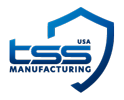How a TEMPEST Power Line Filter Works
TSS USA Manufacturing provides low and medium voltage TEMPEST filters to protect power line applications from unplanned EMI and EMP events.
Our TEMPEST filters meet the following standards at minimum:
- UL1283 (in process)
- Low Voltage Directive
- MIL-STD-220
- MIL-F-15733
Several specific models meet additional requirements.
By their nature and construction, electronic devices can have two problems with electromagnetic interference, or EMI. Antennas, wiring, enclosures, and even power and data cables can enable interference to reach the device.
But for high-security, heavily regulated applications, and commercial proprietary applications—certainly military and national security, but also in such areas as healthcare, finance, energy, transportation, communications, and industrial—there is a problem because the same factors that can allow the incursion of interference and signals can also permit their transmission.
The potential issue was first discovered in military equipment during World War II when it was discovered that encrypted communications could be captured in plain text at a distance. Since then, it has continued to be a problem. This is a particular issue with power sources because a device usually connects to distributed power and then signals moving back through the power circuitry can be broadcast through radiation or conduction.
Radiated emissions dissipate over distance. Barriers, like walls, ceilings, and floors, can reduce the transmission range. Adding a shielded metal mesh enclosure around the device, called a Faraday cage, can rapidly attenuate the signals, safeguarding safeguard that weakness.
A bigger problem is conducted emissions. They travel back into the power wiring of the building and possibly much further. And then, cables and wires can act like antennas, broadcasting the information and allowing someone to monitor the information.
TEMPEST filters can help eliminate unplanned emanation of EMI and, with it, sensitive, confidential, and classified information that might allow access to unauthorized persons.
TEMPEST, which stands for Transient Electromagnetic Pulse Emanation Standard, is a U.S. National Security Agency and NATO specification and certification to prevent eavesdropping and signal interception because of unplanned outgoing EMI. In addition to the use of shielding, physical isolation, and masking, filters are a regular component in solutions, both in government and public sectors.
There are three levels of shielding in the standards: SDIP-27 Level A and USA NSTISSAM Level I, which means someone trying to intercept information might have access within a meter of the equipment.
SDIP-27 Level B or USA NSTISSAM Level II is when someone is within 20 meters.
SDIP-27 Level C and USA NSTISSAM Level III is when there is a clear space of 100 meters, or less if signals can be sufficiently attenuated through building structure and other shielding.
A TEMPEST power filter connected to the power line, according to a declassified specification, provides a 100 dB insertion loss across a broad spectrum of signals (from 14 KHz to 10GHz in TSS USA Manufacturing TEMPEST power line filters). Because decibels are a logarithmic unit, that’s 0.001% of the original signal.
TSS USA Manufacturing TEMPEST filters are manufactured using predominately U.S.-sourced materials and meet the FAR 52.225-1 Made in America.



